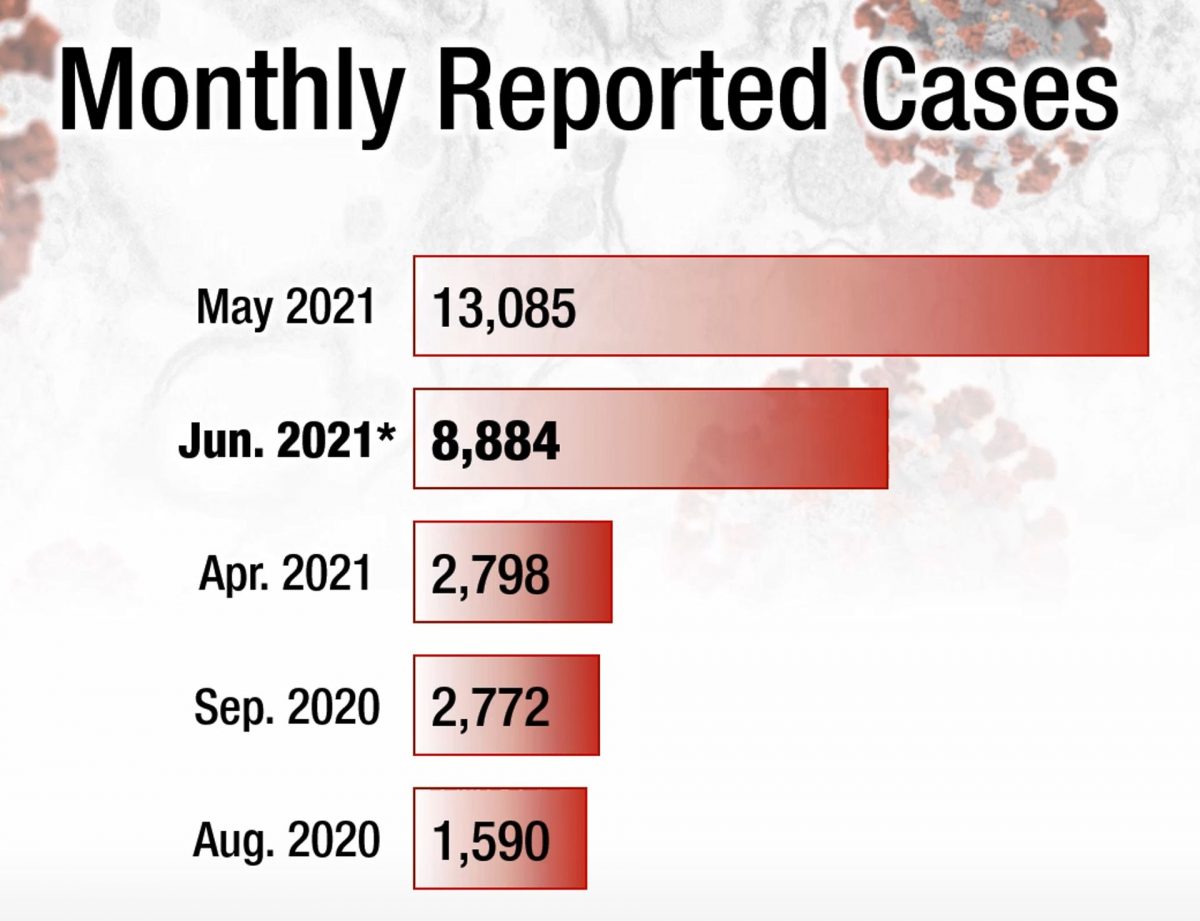(Trinidad Guardian) It was a record no one expected we would surpass.
June 2021 ended as Trinidad and Tobago’s deadliest month for COVID-19 on record, with 352 people succumbing to the disease in the last 30 days and the total death toll now standing at 847.
Health officials continue to repeat the country’s COVID-19 numbers are decreasing, but how significant has the decline been?
As of June 30, 2021, one in 39 COVID-19 cases has lost their fight with the disease and one in 1,675 people in the country has COVID-19 listed as their cause of death.
The country’s cases are slowly decreasing, with the latest seven-day rolling average now at 227 cases per day. COVID-19 has touched nearly every family in the country, with one in 39 people in Trinidad and Tobago testing positive for the disease.
Preliminary numbers for June 2021 places it at the second-highest for T&T regarding the number of people tested and cases. The month takes the top spot for the highest number of deaths, recoveries and vaccines distributed.
June 2021 ended with 352 people losing their lives to COVID-19. This monthly death toll is over 2.75 times the death toll for the entirety of 2020 and recorded 26 more deaths than the last deadliest month, May 2021, where 326 people succumbed to the disease.
During June, there were 20 days where over ten deaths were reported. In the last month, T&T lost one of its youngest victims to COVID-19, a teenage female. Teenagers account for less than one per cent of the country’s COVID-19 deaths.
It took 402 days for T&T to cross 10,000 COVID-19 cases from March 12, 2020, when the first case was detected. It then took 26 more days to cross 20,000 cases during May 2021. It took exactly 26 more days for the country to cross 30,000 cases on June 18.
As of June 30, the country has reported 8,884 COVID-19 cases for the entire month. However, due to the delay in results, this number is expected to rise. The current number is still over 1,700 cases compared to 2020, but 4,201 cases less than T&T’s most infectious month.
The preliminary number of samples submitted for testing, at 49,810, in the last month, marks the second-highest number of samples submitted within a month for the pandemic to date. The actual number is likely higher, as samples submitted by private laboratories are batch reported, with the updated figure not supplied by the Ministry of Health as of press time.
Naturally, with increased cases, there will be both increased hospitalisations and recovered patients. The Ministry of Health notes that the overall hospital occupancy levels have been on the decrease, with the overall occupancy at 51 per cent. However, there are still high ICU and HDU occupancies, indicating the sick population is still becoming severely ill with COVID-19.
In June 2021, approximately 206,698 doses of WHO-approved vaccines have been administered. A total of 118,961 people received their first dose of either an Oxford/AstraZeneca, Sinopharm, or Pfizer vaccine, and 87,737 people receiving their second dose.
Looking at Tobago, 9,011 doses were administered in June, equally distributed, with 4,509 people receiving their first dose and 4,502 people receiving their second dose of a WHO-approved COVID-19 vaccine.
Why such high cases, deaths in the middle of a lockdown?
According to Dr Avery Hinds, the Technical Director of the Ministry of Health’s Epidemiology Division, even with the strict regulations and the State of Emergency, officials are not seeing a decrease in movement at the same level as last year during similar lockdowns.
Dr Hinds added, “The more mixing you have, the more slowly the decrease in transmission would occur. Because there is a greater probability of people moving around, they may be asymptomatic or symptomatic and infect others.”
Officials use the seven-day rolling average to track a better reflection reduction in cases. At the start of June, it was 491 cases a day, but the month ended with a rolling average of 227 cases a day.
Addressing the rise in deaths, Dr Hinds explained this as a death lag, with the peak in deaths not coinciding with the peak in cases. He explained, “What you would have seen at the early part of May, there was actually a decrease in the case-fatality rate. The denominator (cases) was increasing, but there weren’t deaths happening at that point in time. Conversely, as the number of new cases decreases, the number of active cases slows at a different rate.”
Internationally, the average lag has been near eight days but widely varies by region.

